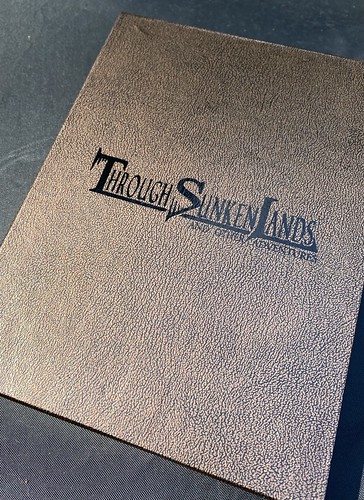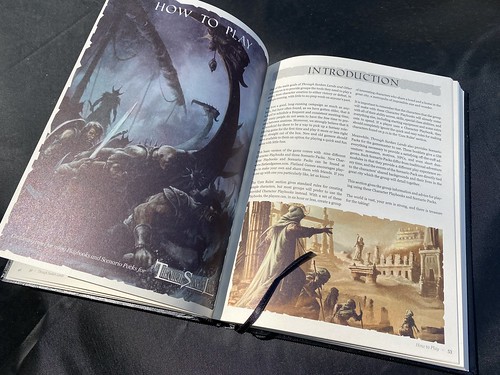
Our heroes have just entered a ruined study and are face to face with a ghostly dragon that grew from a cold ember, the Silver Dragon Argynvost, who they're soon to find out was the founder of the Order of the Silver Dragon, crushed when resisting Count Strahd's conquest of Barovia and turn to darkness.
Our dramatis personae:
Ser Adon de Rouge of House Starbright (a half-orc Paladin, from a knightly background, with two human retainers and a priest), played by Paul (dr_mitch). Lawful Good. Married to Ser Alys.
Kelwarin (Kel) (a half-elf Sorceror flush with the powers of wild magic, an outlander), played by Graham (First Age). Chaotic Good.
Gaddock Teeg (a halfling wizard and former prizefighter), played by Alex (Doggetay), Neutral Good
Ser Alys de Adon-Rouge of House Starbright (a half-orc Fighter with a soldier background, currently the leader of the town militia of Daggerford), played by Tom (Guvnor). Lawful Neutral. Imagine a slightly greener take on Grace Jones... Married to Ser Adon.
also featuring:
Ireena Kolyana (a human warrior, daughter of the Burgomaster of Barovia, Twice-Bitten reincarnation of Strahd's unrequited love, Tatyana) - upgraded as a sidekick.
with :
Alexei the Vistana (a young human expert, sent to pay off his debt to the party by his Vistani elders after they rescued Arabelle from certain death when Alexei lost her in town. A late teenager who is so taken by Ireena and the excitement of the adventure that he's forgotten he planned to be sulky and surly for his 13 moon exile) - upgraded as a sidekick.
All characters are presently 6th level, including the sidekicks.
5th December, mid afternoon
Ser Alys continues to put Vallaki straight as described in the previous entry of the blog. The remainder of our brave heroes are on the third floor of the ruined manse of Argynvostholt where, battered and bruised from the combat with the Revenant Knights, they now face a substantially larger dragon, silver, ghostly, with frost forming where it touches the floor. Quite a presence and also probably not at its full natural size.
Respectfully, they questioned the spirit of Argynvost about what had happened and why it was in the state it was. The dragon-spirit explained that his order had resisted Strahd as he turned to evil and that they had been defeated. Argynvost had been slain on the battlefield and his body brought back to be laid to rest. But something had happened; he could no longer talk to his knights, but could feel that they had become cold and consumed with hatred. Something had corrupted them and made them unable to rest. Argynvost was convinced that if they could remove whatever had corrupted his connection to his Order and stopped the silverly light of the beacons shining out then he would be able to reach out to his knights again and bring them to their rest. He knew that several hundred years had passed since he had died, but not the exact number as he had been diminished. He also mentioned that Strahd gained his powers from a temple to Dark Powers to the south; they had granted him unlife and power over the valley and realm.
At the end of their conversation, a gust of wind blew through the room, and Argynvost collapsed back to an ember in the hearth in the room, preparing to endure after the lift that the party's hope and optimism had brought. With the wind blew the final page from the dragon's journal, revealing more about his passing.
My knights have fallen, and this land is lost. The armies of my enemy will not be stopped by sword or spell, claw or fang. Today I will die, not avenging those who have fallen, but defending that which I love—this valley, this home, and the ideals of the Order of the Silver Dragon.
The evil surrounds me. The time has come to throw off this guise and who these heathens my true fearsome form. Let it spark terror in their hearts! Let them tell their stories of dark triumph against the protector of the Balinok Mountains! Let Argynvost be remembered as a dragon of honor and valor. My one regret is that my remains will not lie in their rightful place, in the hallowed mausoleum of Argynvostholt. No doubt my bones will be scattered among my enemies like the coins of a plundered hoard, trophies of a hard-won victory.
I do not fear death. Though my body will die, my spirit will live on. Let it serve as a beacon of light against the darkness. Let it bring hope to a land wrought with despair.
Now, to battle!
They also found a burned and damaged book under a collapsed armchair. Titled The Oath Celestial, it was partially burned, and its cover slashed by a sword. Leafing through the crumbling book revealed that it was a devotional text for knights from a place called the Holy Empire of Valentia, a place that they hadn't heard of but it seemed that most of the Order came from that land.
There was a damaged painting that showed the house in better days, completely with a silvery beacon of light shining from the top of the tower above the chapel where they'd found the three revenants. Behind the house were mountains that could no longer be seen because of the walls of mists that surround Barovia.
They decided that they'd find the beacon and try and re-light it. They'd no plans to fight, so they didn't rest up. Instead, Ser Adon laid his hands on Alexei and healed him through the power of his faith. Gaddock looked out the window and noticed that there were two stairwells to the east which would probably be the best way up. They decided to make sure that this floor was clear and safe before they headed up. They entered the turret room where they'd seen a figure when they first arrived and found noting except plenty of bedding arranged in a next. This could well have been Argynvost's bedroom.
Searching further, they found a gallery above the chapel with beautiful stained glass windows of Saint Andrew, the Morninglord and Saint Markova. They passed through a ruined bathroom with a collapsed roof, open to the sky above, and then found themselves back at the large chamber near where they initially met Argynvost on this level. Looking ahead, they could see a large receiving room with a throne, with collapsed and damaged walls around. There was the body of a knight in plate armour seated on the throne with one hand on the arm of the chair and the other grasping the hilt of a beautiful greatsword with a dragon hilt and black jewel.
A whispered conversation followed - perhaps the issue was that this individual needed to be properly laid to rest. Ser Adon walked over and prayed for the repose of the corpse, and then reached out to pick it yp and carry it out to be buried. Before he could, a steely hand intercepted his and the corpse opened its eyes, explaining that 'a corpse should be left alone to rest' and demanding to know who they were.
Gaddock launched into a respectful spiel that they were seeking assistance to destroyed Strahd, and was surprised to see the creature becoming angry. It argued that anyone who did something about the vampire-lord's punishment was trying to release him from the personal hell he was in, perpetually having to repeat his failure and losing his true love again and again. Barovia was a punishment for the Dark Lord and this knight, the former leader of Argynvost's hosts, had sworn to make sure that the vampire suffered eternally. Anyone who opposed this would face his wrath. Kel and Adon tried to convince the knight - Vladimir Horngaard - that this was wrong, but he was adamant in his views. Ser Adon became increasingly angry and attacked the knight with his radiant blade. He landed two solid blows.
The knight then stood up and looked at Ser Adon with piercing, terrifying blue eyes. It disquieted the knight, freezing him in place in terror. The knight then drew its blade, and in three shot blows had Ser Adon on the floor, bleeding out. Preparing to risk their lives to save their colleague, Sir Vladimir gave the party and chance to denounce their foolish plans and take the body of their friend. They quickly acquiesced, with Kel and Ireena dragging Adon's body out. They managed to poor a healing potion into him and get him breathing. They retreated into the turret with the soft furnishing, blocking the doors behind them, and preparing to spend the night there.
6th December
Fortunately, they recovered well overnight, as discretion seemed to be the better part of valour. The next morning, they followed Gaddock's advice and headed up to the roof. They found the entrance to the beacon tower was locked, so Alexei started to pick the lock. Suddenly, something was firing ghostly arrows at them; Kel spotted phantasmal creatures with long bows in the stair well windows, Adon confirmed that they were undead. They quickly entered, with Alexei managing to avoid being hurt. He found a sign carved into stone:
Here lie the bones of Argynvost, lord of Argynvostholt and
founder of the Order of the Silver Dragon.
The stairs wound up two floors, and they were dominated by the corpse of a dragon, or rather, the skeleton of Argynvost. Gingerly heading up, Gaddock established that the skull was missing, and that the dragon claw they had found was from this body. Ser Adon identified that it was likely the corruption was an after-effect of the theft of the dragon's skull. Gaddock drew on the legend lore spell he had a casting of; it established that the tomb and beacon tower were overrun by blights led by hags. The skull was located in marshland, with a crude rudder, where it was being used as an unnatural air boat. It was resting beside a hut on legs; Gaddock realised that this was Old Berez and Baba Lysaga.
They decided they'd learnt enough, so quickly exited the mansion and headed back to Vallaki, which they reached unimpeded just after noon. They were reunited with Ser Alys, and all seemed to be well.
GM Notes: An interesting session which brought the season to an end a session earlier than I'd planned. It's clear that no lessons have really been learnt over the last three battles, with Ser Adon being taken down brutally hard. He was lucky to survive. This is a really dangerous location for level 6 characters. However, they've levelled up after concluding this session, so are now Level 7.
There are three real routes from here; follow the links to Old Berez, face the Dark Powers in the Amber Temple or take up Count Strahd on his invite to dinner. The latter is probably the safest provided they mind their Ps & Qs. The Amber Temple is extremely dangerous, Old Berez a little less so.
The new scripts in Roll20 - Aura/Tint, StatusInfo, CombatTracker and GMsheet all worked really well and were worth spending the time investigating and implementing.
Whether or not we return next week will depend how quickly the players make their mind up on the next stop on their journey.
20 April 2022













